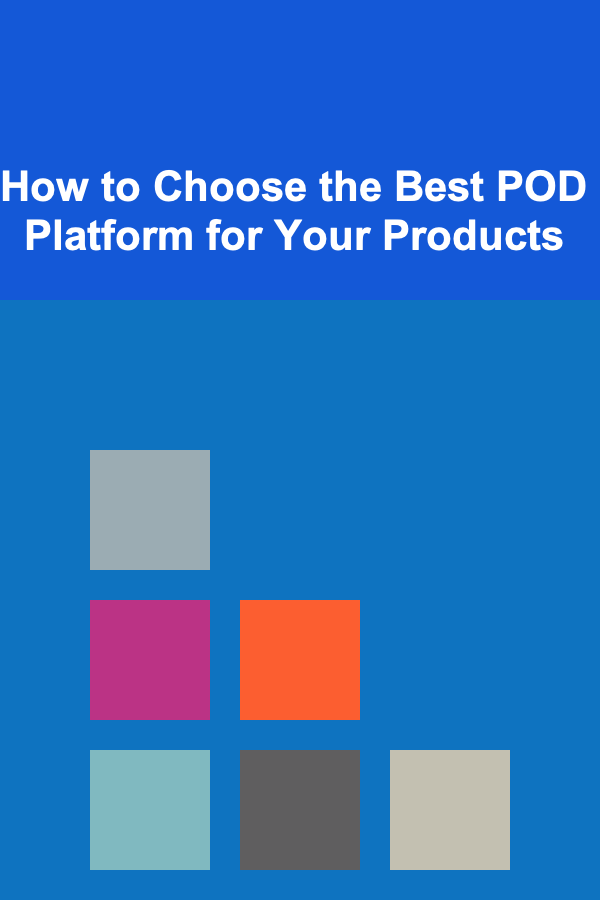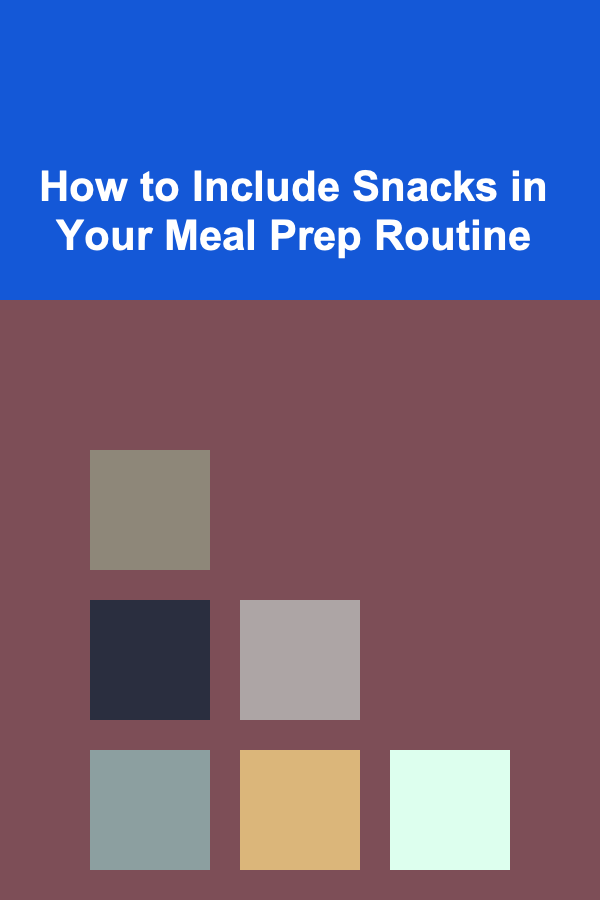
How to Choose the Best POD Platform for Your Products
ebook include PDF & Audio bundle (Micro Guide)
$12.99$8.99
Limited Time Offer! Order within the next:

In the world of eCommerce, print-on-demand (POD) services have emerged as one of the most popular and effective ways to sell custom products online. POD allows entrepreneurs to create and sell products without having to invest in inventory or manage fulfillment, making it a great option for those starting small or those with niche products. However, with the growing number of POD platforms available, choosing the best one for your specific needs can be a daunting task.
This comprehensive guide will explore the factors you should consider when selecting the best POD platform for your products. From understanding the basics of POD to evaluating platform features, costs, and support services, we will provide you with the tools to make an informed decision that will help you grow your business.
What is Print on Demand?
Print-on-demand is a business model in which products are printed, customized, and shipped only when an order is placed. This contrasts with traditional retail models, where companies produce large quantities of products in advance and store them until sold. In a POD setup, you can offer custom products like t-shirts, mugs, posters, and more, without worrying about holding inventory or managing complex logistics.
When a customer places an order, the POD provider handles everything from printing the design to packaging and shipping the product to the customer. As a seller, your role is to design the products, market them, and provide excellent customer service. The POD provider takes care of the production and fulfillment process.
The Rise of POD Platforms
Over the last decade, the print-on-demand industry has experienced significant growth, thanks to the rise of online marketplaces and eCommerce platforms. More entrepreneurs are seeking ways to start their businesses with minimal upfront costs, and POD offers a solution to that. As a result, numerous POD platforms have been created, each offering unique features and benefits.
However, with so many options available, choosing the best platform for your specific needs requires careful consideration. Factors like product offerings, pricing, ease of use, integrations, shipping times, and customer support all come into play.
Key Factors to Consider When Choosing a POD Platform
1. Product Selection and Quality
The range of products offered by a POD platform is crucial when selecting the right one. Some platforms focus solely on clothing, while others offer a wider array of products, such as mugs, tote bags, phone cases, home décor items, and more. Depending on your niche and the kind of products you want to sell, you'll need to ensure the platform offers high-quality products in your desired categories.
In addition to the variety, the quality of the products is equally important. A low-quality product can lead to negative reviews, refunds, and a damaged brand reputation. Be sure to check the materials and production processes of the products offered by the platform. If possible, order samples to evaluate the print quality, fabric, and finishing.
2. Pricing and Profit Margins
POD platforms typically work by offering products at wholesale prices, and you set your retail price. Your profit margins are determined by the difference between the wholesale price and your retail price. It's important to choose a platform with competitive pricing that allows you to maintain a healthy profit margin.
While low-priced platforms may seem appealing, they may sacrifice product quality or have higher shipping costs. On the other hand, platforms with higher product costs may provide better quality and faster shipping, which can lead to happier customers and more sales in the long term. As you evaluate platforms, consider both product costs and shipping fees when calculating potential profits.
3. Ease of Use
The ease of use of a POD platform is essential, especially if you are just starting out in eCommerce. Some platforms have user-friendly interfaces that make it easy to upload designs, customize products, and set up your online store, while others may require more technical expertise.
Look for a platform that provides an intuitive design interface, allowing you to upload designs quickly, position them on products, and preview them in real-time. A simple, streamlined process will help you save time and avoid frustration, especially as you scale your business.
4. Integrations with eCommerce Platforms
A key consideration when choosing a POD platform is its ability to integrate with the eCommerce platform you're using or planning to use. Many POD services integrate with popular eCommerce platforms such as Shopify, WooCommerce, Etsy, and BigCommerce. These integrations allow you to easily sync products, manage orders, and automate the fulfillment process.
For example, Shopify integrates with many POD platforms, allowing you to add custom products to your store and have them automatically fulfilled when an order is placed. This level of automation saves time and ensures a seamless experience for both you and your customers.
Make sure to check the integrations offered by each POD platform to ensure compatibility with your preferred eCommerce platform.
5. Shipping and Delivery Times
One of the most important factors for customer satisfaction is shipping times. Delays in fulfillment and delivery can lead to poor reviews, customer complaints, and increased refund requests. Therefore, it's crucial to select a POD platform that offers reliable and fast shipping options.
Many POD platforms have fulfillment centers located in various regions to reduce shipping times. For example, platforms that fulfill orders from the U.S. to U.S.-based customers will typically have faster delivery times than those that ship from overseas. Be sure to check the shipping options, delivery times, and shipping rates for different countries and regions to ensure they meet your customers' expectations.
Additionally, look for platforms that offer tracking numbers and reliable delivery services. This adds transparency to your business and enhances customer trust.
6. Customer Support and Communication
When running a POD business, you need reliable customer support, especially if issues arise with orders, printing, or shipping. Some POD platforms provide 24/7 customer support through email, live chat, or phone, while others may offer limited support hours.
Research the level of customer support provided by each platform, read reviews, and ensure that their support team is responsive and helpful. Having a strong support system in place will make it easier for you to manage any issues with your products or orders.
7. Branding and Customization Options
Branding is crucial for establishing your identity and differentiating your business from competitors. Many POD platforms offer customization options such as branded packing slips, custom packaging, and branded labels. These features give your products a professional and personalized touch, enhancing the overall customer experience.
Look for a platform that allows you to add your brand's logo to packing slips or offer custom packaging for an added fee. A branded unboxing experience can be a powerful marketing tool and can help foster customer loyalty.
8. Print Quality and Techniques
Different POD platforms use various printing techniques such as Direct to Garment (DTG), sublimation printing, screen printing, or embroidery. Each method has its pros and cons depending on the product type and design complexity.
For example, DTG is excellent for printing intricate, multi-color designs on t-shirts, while sublimation is ideal for polyester fabrics and products like mugs. Screen printing works well for large print runs of simple designs, and embroidery is perfect for hats and jackets. Understanding the printing technique that suits your products and designs will help you choose the best platform.
If print quality is a priority for you, order samples from different platforms to compare the results and determine which one meets your standards.
9. Reviews and Reputation
Finally, take the time to research reviews and feedback from other entrepreneurs who have used the POD platforms you're considering. User reviews can provide valuable insights into the platform's strengths and weaknesses, such as print quality, customer service, and shipping reliability.
Look for honest reviews from people who are in a similar niche or industry to ensure their experiences are relevant. Join online communities or forums where POD sellers gather to share their experiences and recommendations.
Popular POD Platforms
Here are a few popular POD platforms that cater to a variety of needs:
1. Printful
Printful is one of the most well-known and widely used POD platforms, offering a large selection of products, including clothing, accessories, home décor, and more. It integrates with major eCommerce platforms like Shopify, WooCommerce, and Etsy. Printful is known for its high-quality products and fast shipping times.
Pros:
- Wide range of products
- Excellent print quality
- Easy integration with eCommerce platforms
- Custom branding options
Cons:
- Higher product prices compared to some competitors
- Limited control over packaging and customization
2. Printify
Printify offers a wide range of products, including apparel, accessories, and home goods. It works with several printing partners worldwide, which helps lower production costs and shipping times. Printify's flexible pricing structure and wide range of product options make it a popular choice for many entrepreneurs.
Pros:
- Extensive product catalog
- Competitive pricing
- Multiple printing partners for global fulfillment
Cons:
- Variable print quality depending on the print provider
- Customer support can be slow at times
3. Teespring (now Spring)
Teespring, rebranded as Spring, is a platform focused on apparel and lifestyle products. It is particularly popular among creators, influencers, and artists looking to sell custom merchandise. Spring is known for its easy-to-use platform and strong integration with social media platforms.
Pros:
- Great for creators and influencers
- Integration with social media platforms like Instagram and YouTube
- No upfront fees or inventory
Cons:
- Limited product offerings compared to other platforms
- Higher platform fees than some competitors
4. Gooten
Gooten is another POD service offering a broad range of products and fulfillment options. It integrates with popular eCommerce platforms like Shopify, WooCommerce, and Etsy. Gooten is known for its user-friendly interface and competitive pricing.
Pros:
- Wide product selection
- Reliable customer support
- Good pricing structure
Cons:
- Somewhat limited customization options
- Print quality can vary across product categories
5. SPOD (Spreadshirt)
SPOD is a POD platform that prides itself on speed, with production times as fast as 48 hours. It offers a good range of products, including apparel, accessories, and home décor. SPOD also offers a robust integration system with Shopify, WooCommerce, and Etsy.
Pros:
- Fast production times
- Competitive pricing
- Wide range of products
Cons:
- Limited customization features
- Print quality may vary depending on product type
Conclusion
Choosing the best POD platform for your products requires evaluating several factors, including product selection, pricing, shipping times, integrations, and support. By carefully considering these aspects and doing your research, you can find a platform that aligns with your business goals and ensures long-term success.
Starting a POD business is an exciting opportunity, and with the right platform, you can turn your creative designs into profitable products while avoiding the hassle of managing inventory. Take the time to test different platforms, order samples, and explore user reviews to make an informed decision that will help you build a thriving eCommerce business.

How to Clean and Freshen Your Home Without Overwhelming Yourself: An Actionable Guide
Read More
How to Include Snacks in Your Meal Prep Routine
Read More
How to Make the Most of Family Activities in the House
Read More
How to Plan for Insurance and Appraisal of Valuable Antiques
Read More
How To Protect Your Brain from Digital Overload
Read More
Exploring the Mystical Lands of Peru
Read MoreOther Products

How to Clean and Freshen Your Home Without Overwhelming Yourself: An Actionable Guide
Read More
How to Include Snacks in Your Meal Prep Routine
Read More
How to Make the Most of Family Activities in the House
Read More
How to Plan for Insurance and Appraisal of Valuable Antiques
Read More
How To Protect Your Brain from Digital Overload
Read More